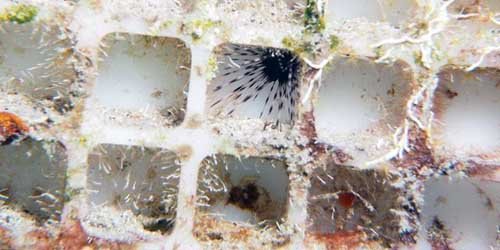Diadema sea-urchins play a vital role in maintaining a balanced coral reef ecosystem and their restoration is essential to assist recovery of the degraded coral reefs around Saba and St. Eustatius. A collaborative effort between the University of Applied Sciences Van Hall Larenstein, WUR, STENAPA, CNSI and NIOZ studied settlement rates of sea-urchin larvae. The new findings provide insight into why the Diadema population has not been restored since the massive die-off in the mid-1980’s and are important for developing and implementing effective sea urchin restoration projects.

Long-spined sea urchins (Diadema antillarum) play a critical role in maintaining healthy coral reefs. They help sustain the delicate balance within the reef by grazing on algae, which are the main competitors of corals. Unfortunately, in the mid-1980s, a disease swept through the Caribbean, wiping out nearly the entire sea urchin population. Soon after, reports of rapid algae growth were documented throughout the Caribbean. The algae occupy all available space, preventing coral recruitment and limiting the coral reef’s ability to recover from other disturbances. So far, the recovery of D. antillarum populations has been very slow to nonexistent. In the few areas where sea urchins were able to naturally recover, these trends were reversed, highlighting the importance of restoring this keystone species.
Studying sea-urchin settlement
A collaborative study between Van Hall Larenstein, Wageningen University and Research (WUR), STENAPA, Caribbean Netherlands Science Institute (CNSI) and NIOZ Royal Netherlands Institute for Sea Research worked to unravel the mystery behind the slow recovery rate of these vital species. As both juveniles and adults are absent from most reefs, it is likely that the bottle-neck in D. antillarum recovery occurs in the first phase of the life cycle. Sea urchins start their life as larvae and remain in the water column for 30-60 days until they find a suitable place to settle. Understanding settlement rates and patterns will help understand the slow recovery and guide recovery efforts moving forward.
Effectiveness of settlement collectors
Settlement collectors were set up in five different locations around the island of St. Eustatius. Between April and December 2019, researchers carefully monitored and analyzed the settlement rates by counting each individual sea urchin larvae which settled on the collectors. Over these 10 months, more than 890 sea urchin settlers were collected. Furthermore, this study compared different materials to identify the most suitable settlement collector for Diadema sea urchins. These materials included panels, artificial turf, bio balls, frayed ropes and a doormat collector. Results showed both the bio ball and doormat collectors were most effective, especially when placed mid-water column.
The mystery behind the slow recovery
Despite high settlement densities on several locations, no juvenile or adult sea urchins were observed on the reefs around the settlement collectors. This hints that there are likely other reasons these populations have been unable to recover around the island. Furthermore, previously conducted reef surveys from 2017 through 2019 found less than 0.01 sea urchins per square meter, far below pre-die-off densities. The fact that this study proves there are sea urchin larvae in the water paired with the lack of juveniles on reefs could be an indication of high predation pressures on settlers on the reef.
Future Populations
One solution which may aid in the restoration of this species would be to collect settlers from the reef and raise them in land-based nurseries. This would protect them from predation early in life and allow them to grow to adequate size before being returned to the reef. In order for this to be economically feasible, high numbers of settlers would need to be collected. Studies such as this can help the islands design and implement effective methods to restore Diadema sea urchins, which can help coral reefs to recover from disturbances naturally.
To learn more, you can read the full article on the Dutch Caribbean Biodiversity Database
See also the recent item in Atlas (NPO2) in Dutch- starts at 22 min:
https://www.npostart.nl/atlas/02-02-2022/VPWON_1335373
DCNA

 Saba News News and Information from Saba Island, Dutch Caribbean
Saba News News and Information from Saba Island, Dutch Caribbean
